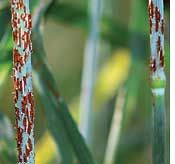How it affects
 Ug99's symptoms are dark orange pustules on the stems and the leaves. Stems can be completely girdled by the pustules damaging the tissue and preventing grain fill. This can bring in yield losses of up to 70 per cent. The disease is so strong that it can even wipe out fields. If the stem rust arrives early in the growing cycle, losses are higher. Ug99 can infect many commonly grown stem rust resistant wheat too. It is resistant to the three major anti-rust genes used in nearly all the world's wheat.
Ug99's symptoms are dark orange pustules on the stems and the leaves. Stems can be completely girdled by the pustules damaging the tissue and preventing grain fill. This can bring in yield losses of up to 70 per cent. The disease is so strong that it can even wipe out fields. If the stem rust arrives early in the growing cycle, losses are higher. Ug99 can infect many commonly grown stem rust resistant wheat too. It is resistant to the three major anti-rust genes used in nearly all the world's wheat.
Scientists are assessing the first Ug99-resistant varieties of wheat that might be used for crops. However, it will take years to breed up enough seed to plant all wheat fields, says a report in NewScientist. "The real solution is disease resistance that relies on a number of genes,' says Rick Ward, a scientist with CIMMYT. Scientists say that with several genes involved it will be much harder for the fungus to become infectious. Pakistan is planning to adopt this mechanism. CIMMYT and others recently uncovered some wheat types which it says "show promise' against Ug99 during experiments in Kenya and Ethiopia.
Related Content
- State of the Climate in Asia 2024
- Order of the National Green Tribunal regarding large scale felling of toddy yielding palm trees in Bihar, 05/06/2025
- Order of the National Green Tribunal regarding pollution of Godavari river, Telangana, 29/05/2025
- Sub-Saharan Africa’s Economic Outlook 2025: Navigating Uncertainty and Aligning Policy for Sustainable Recovery
- Order of the National Green Tribunal regarding sinking of Liberian ship off the Kochi coast, Kerala, 27/05/2025
- At a breaking point: The impact of foreign aid cuts on women's organizations in humanitarian crises worldwide
